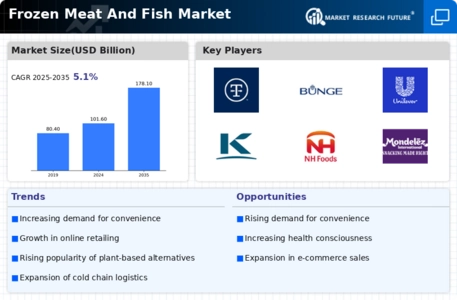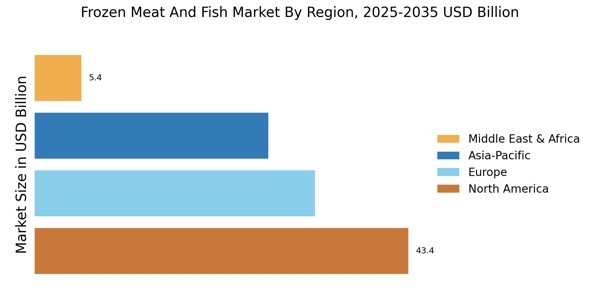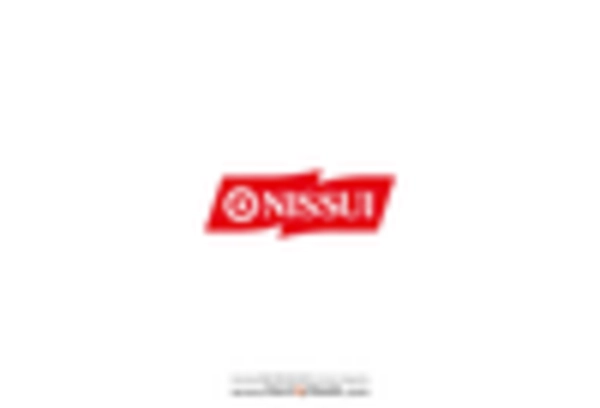Increased Focus on Health and Wellness
Health consciousness among consumers is significantly influencing the Frozen Meat And Fish Market. With a growing awareness of the nutritional benefits of fish and lean meats, consumers are more inclined to incorporate these products into their diets. Data suggests that fish consumption has risen by 10% in recent years, as it is recognized for its omega-3 fatty acids and other health benefits. Additionally, frozen options often retain their nutritional value, making them an attractive choice for health-focused individuals. The industry is responding by offering a wider range of healthy frozen meat and fish products, including organic and low-sodium options. This trend indicates a potential for growth in the Frozen Meat And Fish Market, as health-conscious consumers continue to seek out nutritious and convenient food choices.
Rising Global Population and Urbanization
The rising The Frozen Meat And Fish Industry. As urban areas expand, there is a corresponding increase in demand for convenient food options that cater to busy lifestyles. The urban population is projected to reach 68% by 2050, which suggests a growing need for accessible and quick meal solutions. Frozen meat and fish products fit this demand perfectly, as they offer convenience without sacrificing quality. Additionally, urban consumers are often more exposed to diverse culinary options, leading to an increased interest in various frozen meat and fish products. This demographic shift indicates a potential for growth in the Frozen Meat And Fish Market, as it adapts to the changing preferences of a more urbanized population.
Growing E-commerce and Online Grocery Shopping
The rise of e-commerce and online grocery shopping is significantly impacting the Frozen Meat And Fish Market. With more consumers opting for online shopping, the demand for frozen products is expected to increase. Data indicates that online grocery sales have surged, with frozen food categories experiencing a notable uptick. This shift is attributed to the convenience of home delivery and the ability to easily compare prices and products. Retailers are adapting to this trend by enhancing their online platforms and ensuring that frozen items are readily available for consumers. As e-commerce continues to grow, the Frozen Meat And Fish Market is poised to capitalize on this trend, potentially leading to increased sales and market penetration.
Rising Consumer Preference for Frozen Products
The Frozen Meat And Fish Market is experiencing a notable shift in consumer preferences towards frozen products. This trend is largely driven by the convenience associated with frozen meats and fish, which offer longer shelf life and reduced food waste. According to recent data, the frozen food segment has seen a growth rate of approximately 5% annually, indicating a robust demand. Consumers are increasingly seeking quick meal solutions, and frozen options provide an efficient way to prepare nutritious meals without compromising on quality. This shift is particularly evident among busy households and working professionals who prioritize time-saving solutions. As a result, the Frozen Meat And Fish Market is likely to expand further, catering to the evolving needs of consumers who value both convenience and quality.
Technological Advancements in Freezing Techniques
Technological innovations in freezing techniques are playing a crucial role in shaping the Frozen Meat And Fish Market. Advances such as flash freezing and improved packaging methods enhance the quality and safety of frozen products. These technologies not only preserve the freshness and flavor of meat and fish but also extend their shelf life, which is vital for both retailers and consumers. The implementation of these technologies has led to a reduction in spoilage rates, thereby increasing the overall efficiency of the supply chain. As a result, the Frozen Meat And Fish Market is likely to benefit from enhanced product offerings and improved consumer satisfaction, as these advancements ensure that frozen products meet high standards of quality and safety.


















Leave a Comment